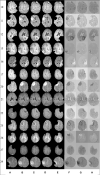Adaptive Physics-Based Non-Rigid Registration for Immersive Image-Guided Neuronavigation Systems
- PMID: 34713074
- PMCID: PMC8521897
- DOI: 10.3389/fdgth.2020.613608
Adaptive Physics-Based Non-Rigid Registration for Immersive Image-Guided Neuronavigation Systems
Abstract
Objective: In image-guided neurosurgery, co-registered preoperative anatomical, functional, and diffusion tensor imaging can be used to facilitate a safe resection of brain tumors in eloquent areas of the brain. However, the brain deforms during surgery, particularly in the presence of tumor resection. Non-Rigid Registration (NRR) of the preoperative image data can be used to create a registered image that captures the deformation in the intraoperative image while maintaining the quality of the preoperative image. Using clinical data, this paper reports the results of a comparison of the accuracy and performance among several non-rigid registration methods for handling brain deformation. A new adaptive method that automatically removes mesh elements in the area of the resected tumor, thereby handling deformation in the presence of resection is presented. To improve the user experience, we also present a new way of using mixed reality with ultrasound, MRI, and CT. Materials and methods: This study focuses on 30 glioma surgeries performed at two different hospitals, many of which involved the resection of significant tumor volumes. An Adaptive Physics-Based Non-Rigid Registration method (A-PBNRR) registers preoperative and intraoperative MRI for each patient. The results are compared with three other readily available registration methods: a rigid registration implemented in 3D Slicer v4.4.0; a B-Spline non-rigid registration implemented in 3D Slicer v4.4.0; and PBNRR implemented in ITKv4.7.0, upon which A-PBNRR was based. Three measures were employed to facilitate a comprehensive evaluation of the registration accuracy: (i) visual assessment, (ii) a Hausdorff Distance-based metric, and (iii) a landmark-based approach using anatomical points identified by a neurosurgeon. Results: The A-PBNRR using multi-tissue mesh adaptation improved the accuracy of deformable registration by more than five times compared to rigid and traditional physics based non-rigid registration, and four times compared to B-Spline interpolation methods which are part of ITK and 3D Slicer. Performance analysis showed that A-PBNRR could be applied, on average, in <2 min, achieving desirable speed for use in a clinical setting. Conclusions: The A-PBNRR method performed significantly better than other readily available registration methods at modeling deformation in the presence of resection. Both the registration accuracy and performance proved sufficient to be of clinical value in the operating room. A-PBNRR, coupled with the mixed reality system, presents a powerful and affordable solution compared to current neuronavigation systems.
Keywords: deep learning; deformable registration; machine learning; medical image computing; mesh generation; mixed reality; neuronavigation systems; neurosurgery.
Copyright © 2021 Drakopoulos, Tsolakis, Angelopoulos, Liu, Yao, Kavazidi, Foroglou, Fedorov, Frisken, Kikinis, Golby and Chrisochoides.
Conflict of interest statement
The authors declare that the research was conducted in the absence of any commercial or financial relationships that could be construed as a potential conflict of interest.
Figures









Similar articles
-
Toward a real time multi-tissue Adaptive Physics-Based Non-Rigid Registration framework for brain tumor resection.Front Neuroinform. 2014 Feb 17;8:11. doi: 10.3389/fninf.2014.00011. eCollection 2014. Front Neuroinform. 2014. PMID: 24596553 Free PMC article.
-
An ITK implementation of a physics-based non-rigid registration method for brain deformation in image-guided neurosurgery.Front Neuroinform. 2014 Apr 7;8:33. doi: 10.3389/fninf.2014.00033. eCollection 2014. Front Neuroinform. 2014. PMID: 24778613 Free PMC article.
-
Non-rigid alignment of pre-operative MRI, fMRI, and DT-MRI with intra-operative MRI for enhanced visualization and navigation in image-guided neurosurgery.Neuroimage. 2007 Apr 1;35(2):609-24. doi: 10.1016/j.neuroimage.2006.11.060. Epub 2006 Dec 23. Neuroimage. 2007. PMID: 17289403 Free PMC article.
-
Comparison of physics-based deformable registration methods for image-guided neurosurgery.Front Digit Health. 2023 Dec 8;5:1283726. doi: 10.3389/fdgth.2023.1283726. eCollection 2023. Front Digit Health. 2023. PMID: 38144260 Free PMC article. Review.
-
IBIS: an OR ready open-source platform for image-guided neurosurgery.Int J Comput Assist Radiol Surg. 2017 Mar;12(3):363-378. doi: 10.1007/s11548-016-1478-0. Epub 2016 Aug 31. Int J Comput Assist Radiol Surg. 2017. PMID: 27581336 Review.
Cited by
-
Image-to-mesh conversion method for multi-tissue medical image computing simulations.Eng Comput. 2024 Dec;40(6):3979-4005. doi: 10.1007/s00366-024-02023-w. Epub 2024 Aug 1. Eng Comput. 2024. PMID: 39717418 Free PMC article.
-
Deep learning in neurosurgery: a systematic literature review with a structured analysis of applications across subspecialties.Front Neurol. 2025 Apr 16;16:1532398. doi: 10.3389/fneur.2025.1532398. eCollection 2025. Front Neurol. 2025. PMID: 40308224 Free PMC article.
-
Automatic framework for patient-specific modelling of tumour resection-induced brain shift.Comput Biol Med. 2022 Apr;143:105271. doi: 10.1016/j.compbiomed.2022.105271. Epub 2022 Jan 30. Comput Biol Med. 2022. PMID: 35123136 Free PMC article.
-
Computer simulation of tumour resection-induced brain deformation by a meshless approach.Int J Numer Method Biomed Eng. 2022 Jan;38(1):e3539. doi: 10.1002/cnm.3539. Epub 2021 Oct 24. Int J Numer Method Biomed Eng. 2022. PMID: 34647427 Free PMC article.
-
SlicerCBM: automatic framework for biomechanical analysis of the brain.Int J Comput Assist Radiol Surg. 2023 Oct;18(10):1925-1940. doi: 10.1007/s11548-023-02881-7. Epub 2023 Apr 1. Int J Comput Assist Radiol Surg. 2023. PMID: 37004646 Free PMC article.
References
-
- Evren G, Chang E, Lamborn K, Tihan T, Chang C, Chang S, et al. . Volumetric extent of resection and residual contrast enhancement on initial surgery as predictors of outcome in adult patients with hemispheric anaplastic astrocytoma. J Neurosurg. (2006) 105:34–40. 10.3171/jns.2006.105.1.34 - DOI - PubMed
-
- McGirt M, Mukherjee D, Chaichana K, Than K, Weingart J, Quinones-Hinojosa A. Association of surgically acquired motor and language deficits on overall survival after resection of glioblastoma multiforme. Neurosurgery. (2009) 65:463–9; discussion: 469–70. 10.1227/01.NEU.0000349763.42238.E9 - DOI - PubMed
-
- Shaw E, Berkey B, Coons S, Bullard D, Brachman D, Buckner J, et al. . Recurrence following neurosurgeon-determined gross-total resection of adult supratentorial low-grade glioma: results of a prospective clinical trial. J Neurosurg. (2008) 109:835–41. 10.3171/JNS/2008/109/11/0835 - DOI - PMC - PubMed
Grants and funding
LinkOut - more resources
Full Text Sources

